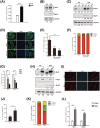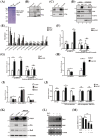Msi2-mediated MiR7a-1 processing repression promotes myogenesis
- PMID: 34877814
- PMCID: PMC8818652
- DOI: 10.1002/jcsm.12882
Msi2-mediated MiR7a-1 processing repression promotes myogenesis
Erratum in
-
Corrigendum to Yang et al. J of Cachexia, Sarcopenia and Muscle, 13, 728-742. https://doi.org/10.1002/jcsm.12882.J Cachexia Sarcopenia Muscle. 2023 Jun;14(3):1586. doi: 10.1002/jcsm.13232. Epub 2023 Apr 11. J Cachexia Sarcopenia Muscle. 2023. PMID: 37041662 Free PMC article. No abstract available.
Abstract
Background: Most of the microRNAs (MiRs) involved in myogenesis are transcriptional regulated. The role of MiR biogenesis in myogenesis has not been characterized yet. RNA-binding protein Musashi 2 (Msi2) is considered to be one of the major drivers for oncogenesis and stem cell proliferation. The functions of Msi2 in myogenesis have not been explored yet. We sought to investigate Msi2-regulated biogenesis of MiRs in myogenesis and muscle stem cell (MuSC) ageing.
Methods: We detected the expression of Msi2 in MuSCs and differentiated myotubes by quantitative reverse transcription PCR (RT-qPCR) and western blot. Msi2-binding partner human antigen R (HuR) was identified by immunoprecipitation followed by mass spectrometry analysis. The cooperative binding of Msi2 and HuR on MiR7a-1 was analysed by RNA immunoprecipitation and electrophoresis mobility shift assays. The inhibition of the processing of pri-MiR7a-1 mediated by Msi2 and HuR was shown by Msi2 and HuR knockdown. Immunofluorescent staining, RT-qPCR and immunoblotting were used to characterize the function of MiR7a-1 in myogenesis. Msi2 and HuR up-regulate cryptochrome circadian regulator 2 (Cry2) via MiR7a-1 was confirmed by the luciferase assay and western blot. The post-transcriptional regulatory cascade was further confirmed by RNAi and overexpressing of Msi2 and HuR in MuSCs, and the in vivo function was characterized by histopathological and molecular biological methods in Msi2 knockout mice.
Results: We identified a post-transcription regulatory cascade governed by a pair of RNA-binding proteins Msi2 and HuR. Msi2 is enriched in differentiated muscle cells and promotes MuSC differentiation despite its pro-proliferation functions in other cell types. Msi2 works synergistically with another RNA-binding protein HuR to repress the biogenesis of MiR7a-1 in an Msi2 dose-dependent manner to regulate the translation of the key component of the circadian core oscillator complex Cry2. Down-regulation of Cry2 (0.6-fold, vs. control, P < 0.05) mediated by MiR7a-1 represses MuSC differentiation. The disruption of this cascade leads to differentiation defects of MuSCs. In aged muscles, Msi2 (0.3-fold, vs. control, P < 0.01) expression declined, and the Cry2 protein level also decreases (0.5-fold, vs. control, P < 0.05), suggesting that the disruption of the Msi2-mediated post-transcriptional regulatory cascade could attribute to the declined ability of muscle regeneration in aged skeletal muscle.
Conclusions: Our findings have identified a new post-transcriptional cascade regulating myogenesis. The cascade is disrupted in skeletal muscle ageing, which leads to declined muscle regeneration ability.
Keywords: HuR; MiR7a-1 processing; Msi2; Myogenesis; Skeletal muscle ageing.
© 2021 The Authors. Journal of Cachexia, Sarcopenia and Muscle published by John Wiley & Sons Ltd on behalf of Society on Sarcopenia, Cachexia and Wasting Disorders.
Conflict of interest statement
The authors declare no conflicts of interests.
Figures





Similar articles
-
HuR and miR-1192 regulate myogenesis by modulating the translation of HMGB1 mRNA.Nat Commun. 2013;4:2388. doi: 10.1038/ncomms3388. Nat Commun. 2013. PMID: 24005720 Free PMC article.
-
RNAi-mediated HuR depletion leads to the inhibition of muscle cell differentiation.J Biol Chem. 2003 Nov 21;278(47):47119-28. doi: 10.1074/jbc.M308889200. Epub 2003 Aug 27. J Biol Chem. 2003. PMID: 12944397
-
Osteoglycin inhibition by microRNA miR-155 impairs myogenesis.PLoS One. 2017 Nov 21;12(11):e0188464. doi: 10.1371/journal.pone.0188464. eCollection 2017. PLoS One. 2017. PMID: 29161332 Free PMC article.
-
Circular RNAs and host genes act synergistically in regulating cellular processes and functions in skeletal myogenesis.Gene. 2025 Mar 10;940:149189. doi: 10.1016/j.gene.2024.149189. Epub 2024 Dec 24. Gene. 2025. PMID: 39724991 Review.
-
HuR and myogenesis: being in the right place at the right time.Biochim Biophys Acta. 2011 Sep;1813(9):1663-7. doi: 10.1016/j.bbamcr.2011.01.036. Epub 2011 Feb 20. Biochim Biophys Acta. 2011. PMID: 21315776 Review.
Cited by
-
Myogenesis controlled by a long non-coding RNA 1700113A16RIK and post-transcriptional regulation.Cell Regen. 2022 Apr 3;11(1):13. doi: 10.1186/s13619-022-00114-x. Cell Regen. 2022. PMID: 35366685 Free PMC article.
-
The role of non-coding RNAs in muscle aging: regulatory mechanisms and therapeutic potential.Front Mol Biosci. 2024 Jan 9;10:1308274. doi: 10.3389/fmolb.2023.1308274. eCollection 2023. Front Mol Biosci. 2024. PMID: 38264571 Free PMC article. Review.
-
Evolutionary conserved circular MEF2A RNAs regulate myogenic differentiation and skeletal muscle development.PLoS Genet. 2023 Sep 7;19(9):e1010923. doi: 10.1371/journal.pgen.1010923. eCollection 2023 Sep. PLoS Genet. 2023. PMID: 37676887 Free PMC article.
-
CRISPR Screen Identifies the RNA-Binding Protein Eef1a1 as a Key Regulator of Myogenesis.Int J Mol Sci. 2024 Apr 28;25(9):4816. doi: 10.3390/ijms25094816. Int J Mol Sci. 2024. PMID: 38732031 Free PMC article.
-
The landscape of aging.Sci China Life Sci. 2022 Dec;65(12):2354-2454. doi: 10.1007/s11427-022-2161-3. Epub 2022 Sep 2. Sci China Life Sci. 2022. PMID: 36066811 Free PMC article. Review.
References
-
- Baghdadi MB, Tajbakhsh S. Regulation and phylogeny of skeletal muscle regeneration. Dev Biol 2018;433:200–209. - PubMed
-
- Zammit PS. Function of the myogenic regulatory factors Myf5, MyoD, Myogenin and MRF4 in skeletal muscle, satellite cells and regenerative myogenesis. Semin Cell Dev Biol 2017;72:19–32. - PubMed
Publication types
MeSH terms
Substances
LinkOut - more resources
Full Text Sources
Miscellaneous

